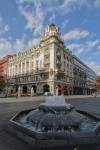
| Sights and monuments in Belgrade |
Belgrade fortress
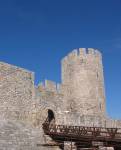 Belgrade fortress was the center of the city for many centuries. It was founded in 4. – 3. century B.C. by Celts. Fortress known as Singidunum (Latin name of Belgrade) consists of The Fortress, divided into Upper Town and Lower Town, and the Kalemegdan park, the most popular promenade for Belgrade citizens.
Belgrade fortress was the center of the city for many centuries. It was founded in 4. – 3. century B.C. by Celts. Fortress known as Singidunum (Latin name of Belgrade) consists of The Fortress, divided into Upper Town and Lower Town, and the Kalemegdan park, the most popular promenade for Belgrade citizens.
Because of its exceptional strategic significance, at the end of the I century A.D. the Romans built a fortress here - Roman castrum, as a permanent military camp of the IV Flavius' legion. After its destruction by the Goths and Huns, it was reconstructed in the first decades of the VI century. Less than a hundred years later, it was destroyed by the Avars and Slavs.
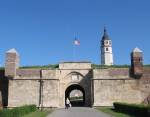 Along the fortress on the hill above the Sava and Danube confluence, the ancient Singidunum has been raised up, and, at the same place the Slavs made their Beograd. The mediaeval town has developed for centuries in the Fortress area, searching for safety within its thick walls. The Belgrade Fortress has been destroyed and renewed for many times. Above the Roman walls there are the Serbian, and above these the Turkish and Austrian fortifications. In the XII century, the Byzantine Czar Manuel Comnenus erected a new castle upon the Roman ruins. In the first decades of the XIV century, this small stronghold on the hill was expanded to the river banks.
Along the fortress on the hill above the Sava and Danube confluence, the ancient Singidunum has been raised up, and, at the same place the Slavs made their Beograd. The mediaeval town has developed for centuries in the Fortress area, searching for safety within its thick walls. The Belgrade Fortress has been destroyed and renewed for many times. Above the Roman walls there are the Serbian, and above these the Turkish and Austrian fortifications. In the XII century, the Byzantine Czar Manuel Comnenus erected a new castle upon the Roman ruins. In the first decades of the XIV century, this small stronghold on the hill was expanded to the river banks.
As a new center of Serbia, under the rule of Despot Stefan Lazarević, Belgrade has been fortified with wide forts of Upper and Lower Towns. At the old castle, despot's palace has been built, and a war port has been built on the Sava. Within the walls, a prosperous mediaeval town has been developed. From 1521, when it was conquered by the Turks, until the XVII century, the Belgrade Fortress has not been significantly expanded.
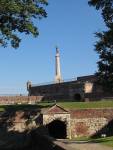 A new period began with the Austrian-Turkish war. Having been the key fortress in the center of war actions during the XVIII century, it has been reconstructed three times. The old castle has been demolished, and a large part of mediaeval walls was covered by new fortifications. Under the Austrian rule, from 1717 to 1739, after the construction of new, modern forts, the Belgrade Fortress became one of the strongest military fortifications in Europe. It was built by the design of the general Nikola Doksat Demorez, the Swiss in Austrian service. His destiny was to be shot right in front of the walls of the Fortress he designed, in a March morning in 1738, because he had lost the Niš battle. All of the new-built fortifications have been destroyed before the Turks returned to Belgrade in 1740. By the end of the XVIII century the Belgrade Fortress got its final shape. In the war destructions during the past decades almost all structures in Upper and Lower Towns have been demolished, while the wall have been considerably damaged.
A new period began with the Austrian-Turkish war. Having been the key fortress in the center of war actions during the XVIII century, it has been reconstructed three times. The old castle has been demolished, and a large part of mediaeval walls was covered by new fortifications. Under the Austrian rule, from 1717 to 1739, after the construction of new, modern forts, the Belgrade Fortress became one of the strongest military fortifications in Europe. It was built by the design of the general Nikola Doksat Demorez, the Swiss in Austrian service. His destiny was to be shot right in front of the walls of the Fortress he designed, in a March morning in 1738, because he had lost the Niš battle. All of the new-built fortifications have been destroyed before the Turks returned to Belgrade in 1740. By the end of the XVIII century the Belgrade Fortress got its final shape. In the war destructions during the past decades almost all structures in Upper and Lower Towns have been demolished, while the wall have been considerably damaged.
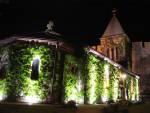 The Knez Mihailova and Uzun Mirkova streets lead to the Belgrade Fortress. At that direction are the main Fortress gates - Stambol Gate (inner and outer) and Sahat Gate. The entrance to the mediaeval fortress was on the eastern side (near today's Zoo), through Zindan Gate and Despot's Gate of Upper Town. The access to Lower Town is from Bulevar Vojvode Bojovića (Vidin Gate) and from Karađorđeva Street (Dark Gate).
The Knez Mihailova and Uzun Mirkova streets lead to the Belgrade Fortress. At that direction are the main Fortress gates - Stambol Gate (inner and outer) and Sahat Gate. The entrance to the mediaeval fortress was on the eastern side (near today's Zoo), through Zindan Gate and Despot's Gate of Upper Town. The access to Lower Town is from Bulevar Vojvode Bojovića (Vidin Gate) and from Karađorđeva Street (Dark Gate).
Kalemegdan park
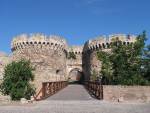 Kalemegdan is the most beautiful and biggest park in Belgrade, which is also the most important cultural and historical complex, in which the Belgrade Fortress stands high above the Sava and Danube confluence. The name Kalemegdan applies only to the spacious plateau surrounding the Fortress, which was turned into a park in the eighties of the XIX century. When the Fortress served as Belgrade's chief military stronghold, the plateau was a place from which the enemy was kept under observation and where preparations were made for combats. Its name derives from the Turkish words kale (field) and megdan (battle). The Turks also called it Fichir-bair, which means "the contemplation hill".
Kalemegdan is the most beautiful and biggest park in Belgrade, which is also the most important cultural and historical complex, in which the Belgrade Fortress stands high above the Sava and Danube confluence. The name Kalemegdan applies only to the spacious plateau surrounding the Fortress, which was turned into a park in the eighties of the XIX century. When the Fortress served as Belgrade's chief military stronghold, the plateau was a place from which the enemy was kept under observation and where preparations were made for combats. Its name derives from the Turkish words kale (field) and megdan (battle). The Turks also called it Fichir-bair, which means "the contemplation hill".
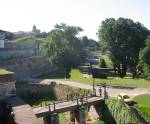 Its conversion into a park began by Prince Mihailo Obrenović's order, once the Fortress was surrendered to the Serbs (1867). The conceptual designs were made by Emilijan Josimović, the first Serbian urbanist. The greenery was planted between 1873 and 1875, when the commanding officer of the Fortress was Colonel Dragutin Žabarac, who was an aide-de-camp to Prince Miloš Obrenović during his second rule.
Its conversion into a park began by Prince Mihailo Obrenović's order, once the Fortress was surrendered to the Serbs (1867). The conceptual designs were made by Emilijan Josimović, the first Serbian urbanist. The greenery was planted between 1873 and 1875, when the commanding officer of the Fortress was Colonel Dragutin Žabarac, who was an aide-de-camp to Prince Miloš Obrenović during his second rule.
Before the First World War, Kalemegdan spread to the now still existing stone stairway (leading to the lower terrace). The ground beyond this stairway remained completely untouched and overgrown with weeds until 1929. In 1931, the park expanded also to Upper Town. Monuments to many famous cultural and public persons were erected in the park. Kalemegdan now includes the Military Museum, Cvijeta Zuzorić Art Pavilion, City Institute for Protection of Cultural Monuments, Zoo, a children's amusement park, a large number of sports fields, restaurants and so on.
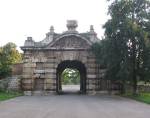 Bronze and stone statue of the victory is the symbol of Belgrade, total height about 14 metres. Erected in 1928.
Bronze and stone statue of the victory is the symbol of Belgrade, total height about 14 metres. Erected in 1928.
In 1912, Meštrović designed a monumental fountain on the theme of the liberation of Serbia from the Turks which was to have stood at Terazije square. The center of the fountain's basin would have contained a five-stepped column representing five centuries of slavery under the Turks and it was intended that the "Victor" should stand on top of this. After the end of World War I the project was given up, so that in 1928 the "Victor" was placed on a column in Kalemegdan as part of the 10th anniversary celebration of the breach of the Thessaloniki Front. This monument is often used as a symbol of Belgrade.
Republic square - Trg republike
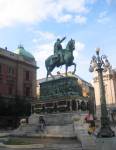 The present square was formed after the demolition of the Stambol Gate in 1866 and the construction of the National Theatre in 1869. The Gate had been built by the Austrians at the beginning of the XVIII century, and stood in the area between the present monument to Prince Mihailo and the National Theatre building. It was the largest and most beautiful town gate at the time when Belgrade was encircled by the moat. It was named after the road which led through it - to Constantinople (Istanbul). The people remembered the Stambol Gate as the place in front of which the Turks executed the "raya", their non-Muslim subjects, by impaling them on stakes. It was also the place where during the attack on Belgrade in 1806 in the First Serbian Insurrection, one of the leading Serb military commanders, Vasa Čarapić, was fatally wounded. In memory of this sad event, a street near the square and a monument in the vicinity were named after him
The present square was formed after the demolition of the Stambol Gate in 1866 and the construction of the National Theatre in 1869. The Gate had been built by the Austrians at the beginning of the XVIII century, and stood in the area between the present monument to Prince Mihailo and the National Theatre building. It was the largest and most beautiful town gate at the time when Belgrade was encircled by the moat. It was named after the road which led through it - to Constantinople (Istanbul). The people remembered the Stambol Gate as the place in front of which the Turks executed the "raya", their non-Muslim subjects, by impaling them on stakes. It was also the place where during the attack on Belgrade in 1806 in the First Serbian Insurrection, one of the leading Serb military commanders, Vasa Čarapić, was fatally wounded. In memory of this sad event, a street near the square and a monument in the vicinity were named after him
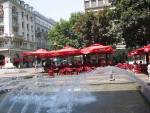 After the establishment of Serbian rule and the demolition of the Stambol Gate, the site of the present square was not laid out for a long time. The National Theatre was the only large building standing here for more than thirty years. The square gradually started to acquire more buildings after the monument to Prince Mihailo was erected in 1882. The place where now the National Museum is, was the location of long single-storied building which housed, among other things, the famous "Dardaneli restaurant". This was the meeting-place of members of the artistic circles of the time. The building was pulled down to make way in 1903 for the Treasury (now the building of the National Museum). In a small park next to the National Theatre, there were the well-known "Kolarac" restaurant and cinema (owned by Ilija Milosavljević - Kolarac, a merchant and benefactor). The "Riunione" Palace, in which the "Jadran" cinema is located today, was built in 1930.
After the establishment of Serbian rule and the demolition of the Stambol Gate, the site of the present square was not laid out for a long time. The National Theatre was the only large building standing here for more than thirty years. The square gradually started to acquire more buildings after the monument to Prince Mihailo was erected in 1882. The place where now the National Museum is, was the location of long single-storied building which housed, among other things, the famous "Dardaneli restaurant". This was the meeting-place of members of the artistic circles of the time. The building was pulled down to make way in 1903 for the Treasury (now the building of the National Museum). In a small park next to the National Theatre, there were the well-known "Kolarac" restaurant and cinema (owned by Ilija Milosavljević - Kolarac, a merchant and benefactor). The "Riunione" Palace, in which the "Jadran" cinema is located today, was built in 1930.
Skadarlija
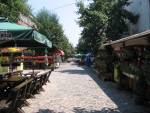 is a vintage street, an urban neighborhood and former municipality of Belgrade, the capital of Serbia. It is located in Belgrade's municipality of Stari Grad and generally considered the main bohemian quarter of Belgrade, styled the Belgrade's Montmartre.
is a vintage street, an urban neighborhood and former municipality of Belgrade, the capital of Serbia. It is located in Belgrade's municipality of Stari Grad and generally considered the main bohemian quarter of Belgrade, styled the Belgrade's Montmartre.
Skadarlija is located less than 300 meters north-west of Terazije, central Belgrade. It begins right below the Square of the Republic and stretches along the street of the same name.
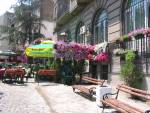 The history of Skadarlija began in the 1830s with the settlement of Gypsies in the abandoned trenches in front of the ramparts. The 1854 town plan of Belgrade reveals that the Gypsy hovels had been replaced by brick buildings into which artisans, caterers, petty clerks and others moved. The whole locality was referred to as the Gypsy Quarter until 1872, when the street was named after the city of Shkodër (Serbian: Skadar), which was part of the Serbian medieval state (today in Albania). Skadarska ulica, Serbian for "Skadar street" is still the official name.
The history of Skadarlija began in the 1830s with the settlement of Gypsies in the abandoned trenches in front of the ramparts. The 1854 town plan of Belgrade reveals that the Gypsy hovels had been replaced by brick buildings into which artisans, caterers, petty clerks and others moved. The whole locality was referred to as the Gypsy Quarter until 1872, when the street was named after the city of Shkodër (Serbian: Skadar), which was part of the Serbian medieval state (today in Albania). Skadarska ulica, Serbian for "Skadar street" is still the official name.
Nikola Pasic square
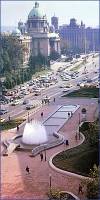 Situated between Terazije, Bulevar Kralja Aleksandra and Moše Pijade Street, it is the youngest Belgrade square. It was built in 1953, when a fountain was placed.
Situated between Terazije, Bulevar Kralja Aleksandra and Moše Pijade Street, it is the youngest Belgrade square. It was built in 1953, when a fountain was placed.
In the first half of the XIX century, this area was an empty field bisected by the road to Constantinople which was at this point in the process of developing into a street. The first name of this street was Golden Cannon Lane, after a restaurant of the same name, and this was later changed to Markova Street. Not far from the site of the present National Assembly, at the beginning of Vlajkovićeva Street, stood the largest of the Turkish mosques, the Batal Mosque, which was pulled down in 1869.
After World War I, the buildings in this area were mainly single and double-storied ones. One of these housed the Belgrade district court (better known as the "Peasant Court"), later the location of a notorious Gestapo prison during the German occupation. Between two world wars the following buildings were constructed: the National Assembly (1936), Agrarian Bank (after the war the seat of Central Committee of the Communist Party of Yugoslavia), then the building of the "Vreme" newspaper (today the "Borba"), the "Beograd" cinema and others.
The urban and architectural development of the square started after World War II, when old buildings were demolished, the tram terminus was moved, new fountain was built, the railings in front of the former palace gardens and the National Assembly were removed and several new buildings erected including the Trade Union Hall, buildings of the City Administration and Investment Bank. This square used to bear the name "Marx and Engels Square" for a long time.
Monument to Nikola Pasic was erected at this square in 1998.
Hotels, hostels, apartments
 If you are seeking for lodging in Belgrade you are on the right place. Accommodation in apartments and hotels in Belgrade and all over the Serbia.
If you are seeking for lodging in Belgrade you are on the right place. Accommodation in apartments and hotels in Belgrade and all over the Serbia.
Travelling to Belgrade
 Looking for some maps of Belgrade and Serbia, air tickets and flights to Belgrade or need to find do you need a visa or some permission?
Looking for some maps of Belgrade and Serbia, air tickets and flights to Belgrade or need to find do you need a visa or some permission?
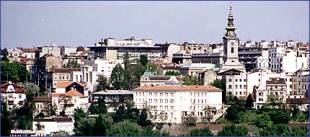 There are spots in Belgrade you must definitely see and feel. Streets, squares, monuments, parks, drinking fountains, archeological sites... and other sights that deserve recommendation. Many of them have been given the status of cultural assets.
There are spots in Belgrade you must definitely see and feel. Streets, squares, monuments, parks, drinking fountains, archeological sites... and other sights that deserve recommendation. Many of them have been given the status of cultural assets.
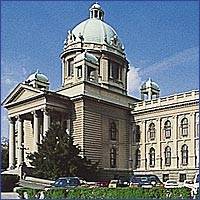 The first design for the House of the National Representation was made by Konstantin A. Jovanović in 1891. At the open competition of 1901 for the building on the area near the Batal mosque, the winning work was that of Jovan Ilkić, which is, in fact, a variant of Jovanović's solution. The construction of the palace began in 1907, and the cornerstone was laid by King Petar I. During World War I, Ilkić has died in the concentration camp in Nežider, while the plans have been lost. In accordance with the completed parts of the building, the new plans have been made by Ilkić's son Pavle, while Nikolaj Krasnov has helped in completion of the building, especially the interior. The construction was not finished until 1936. It was designed in the manner of academic traditionalism, with rich interior (architectural and artistic) decoration, made by, at that time, most famous artists and craftsmen. In 1939, a monumental sculptural group made by the famous sculptor Toma Rosandić was placed in front of the main entrance. It was named "Igrali se konji vrani" (Black horses are playing).
The first design for the House of the National Representation was made by Konstantin A. Jovanović in 1891. At the open competition of 1901 for the building on the area near the Batal mosque, the winning work was that of Jovan Ilkić, which is, in fact, a variant of Jovanović's solution. The construction of the palace began in 1907, and the cornerstone was laid by King Petar I. During World War I, Ilkić has died in the concentration camp in Nežider, while the plans have been lost. In accordance with the completed parts of the building, the new plans have been made by Ilkić's son Pavle, while Nikolaj Krasnov has helped in completion of the building, especially the interior. The construction was not finished until 1936. It was designed in the manner of academic traditionalism, with rich interior (architectural and artistic) decoration, made by, at that time, most famous artists and craftsmen. In 1939, a monumental sculptural group made by the famous sculptor Toma Rosandić was placed in front of the main entrance. It was named "Igrali se konji vrani" (Black horses are playing).
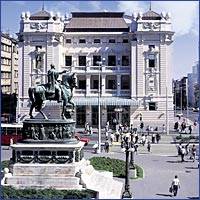 Built in 1869 according to the design of Aleksandar Bugarski, the most productive architect of Belgrade in the XIX century. The decision to construct a special building for the theatre was made by Knez Mihailo Obrenović. The building was a typical theatre building of the time and was particularly reminiscent of La Scala, Milan, with regard to its Renaissance conception and the decorative finish. Later reconstructions, completely changed the original appearance. The heavy reconstruction was made in 1986 when the theatre regained the 1922 look and an annex was built towards Braće Jugovića Street. Beside theatrical purposes, the hall has been used for charity balls and concerts during the XIX century. The Great Constitutional Assembly adopted the famous 1888 Constitution in this building.
Built in 1869 according to the design of Aleksandar Bugarski, the most productive architect of Belgrade in the XIX century. The decision to construct a special building for the theatre was made by Knez Mihailo Obrenović. The building was a typical theatre building of the time and was particularly reminiscent of La Scala, Milan, with regard to its Renaissance conception and the decorative finish. Later reconstructions, completely changed the original appearance. The heavy reconstruction was made in 1986 when the theatre regained the 1922 look and an annex was built towards Braće Jugovića Street. Beside theatrical purposes, the hall has been used for charity balls and concerts during the XIX century. The Great Constitutional Assembly adopted the famous 1888 Constitution in this building.
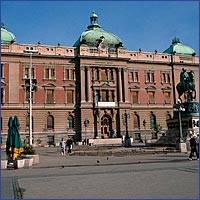 The original corpus against the Trg republike, was built in 1902 according to the design of Andra Stevanović and Nikola Nestorović. The part facing Laza Paču Street was built in 1930, when the counter-hall (today the atrium of the National Museum) was arranged. In World War II the building was heavily damaged, and after the war it was rebuilt without the dome it has today. In the sixties, thanks to the efforts of then the manager of the National Museum, Dr. Lazar Trifunović, the central dome was back in place, and the interior arranged, so that today it fully serves its purpose.
The original corpus against the Trg republike, was built in 1902 according to the design of Andra Stevanović and Nikola Nestorović. The part facing Laza Paču Street was built in 1930, when the counter-hall (today the atrium of the National Museum) was arranged. In World War II the building was heavily damaged, and after the war it was rebuilt without the dome it has today. In the sixties, thanks to the efforts of then the manager of the National Museum, Dr. Lazar Trifunović, the central dome was back in place, and the interior arranged, so that today it fully serves its purpose.
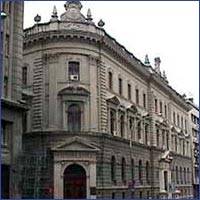 It is the most important work of the Viennese architect of Serbian origin Konstantin A. Jovanović. The building was constructed in two phases: the first corner part against Cara Lazara Street was built in 1888-1889 and the annex in 1922-1925. This annexation is perceived primarily in the interior, because the main entrance originally was at the corner, and now it is in the middle of the building. A complete unity of the style based on neorenaissance was accomplished in the exterior. Richly decorated counter-hall is one of the most representative Belgrade interiors, and then young Belgrade painter Moša Pijade, later a politician and statesman, participated in illustrating the ceiling.
It is the most important work of the Viennese architect of Serbian origin Konstantin A. Jovanović. The building was constructed in two phases: the first corner part against Cara Lazara Street was built in 1888-1889 and the annex in 1922-1925. This annexation is perceived primarily in the interior, because the main entrance originally was at the corner, and now it is in the middle of the building. A complete unity of the style based on neorenaissance was accomplished in the exterior. Richly decorated counter-hall is one of the most representative Belgrade interiors, and then young Belgrade painter Moša Pijade, later a politician and statesman, participated in illustrating the ceiling.
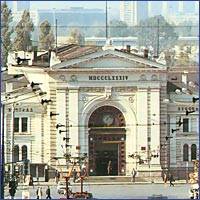 The building for the Railway Station was constructed in 1884, on a reclaimed area of what used to be the "Bara Venecija" (Venice pool). It was made by the ideas of the Viennese architect von Schlicht and the plans of the architect Dragutin Milutinović, the professor at the Faculty of Engineering of the Great School in Belgrade. In that time, it represented a very successful solution, by the harmony of architectural forms (in the manner of classical architecture) as well as by spatial organization. It is in the group of architectural projects which, in the Principality and later Kingdom of Serbia, represented the first acceptance and development of technical achievements of Europe of that period.
The building for the Railway Station was constructed in 1884, on a reclaimed area of what used to be the "Bara Venecija" (Venice pool). It was made by the ideas of the Viennese architect von Schlicht and the plans of the architect Dragutin Milutinović, the professor at the Faculty of Engineering of the Great School in Belgrade. In that time, it represented a very successful solution, by the harmony of architectural forms (in the manner of classical architecture) as well as by spatial organization. It is in the group of architectural projects which, in the Principality and later Kingdom of Serbia, represented the first acceptance and development of technical achievements of Europe of that period.
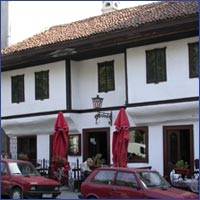 The oldest Belgrade restaurant, built in 1823 as a property of Knez Miloš Obrenović, gifted to Naum Ičko, his commercial consul. It was constructed by the Greek builders in the Balkan style. As soon as 1826, on the ground floor of this building, Ećim-Toma Kostić, the son-in-law of Naum Ičko and a famous healer from the Second Serbian Insurrection (he cured Knez Miloš, too), opened a cafe called "Ećim-Tomina". Since 1878, when it was sold by the successors, it has changed its owners and names. First it was called "Kod pastira" (At Shepherd's) in 1878, then, in 1892 "Kod Saborne crkve" (At the Cathedral Church), but this was soon removed, because it neither complied with regulations on restaurants, nor did the Church authorities find it suitable. As a temporary solution, the owner has put up just a question mark, which has remained until today. Vuk Karadžić used to come to this restaurant in 1830-1831. In 1834 it had the first billiard table in Belgrade, and since the same year, i has been the first reading-room of "Srpske Novine" (Serbian Newspaper).
The oldest Belgrade restaurant, built in 1823 as a property of Knez Miloš Obrenović, gifted to Naum Ičko, his commercial consul. It was constructed by the Greek builders in the Balkan style. As soon as 1826, on the ground floor of this building, Ećim-Toma Kostić, the son-in-law of Naum Ičko and a famous healer from the Second Serbian Insurrection (he cured Knez Miloš, too), opened a cafe called "Ećim-Tomina". Since 1878, when it was sold by the successors, it has changed its owners and names. First it was called "Kod pastira" (At Shepherd's) in 1878, then, in 1892 "Kod Saborne crkve" (At the Cathedral Church), but this was soon removed, because it neither complied with regulations on restaurants, nor did the Church authorities find it suitable. As a temporary solution, the owner has put up just a question mark, which has remained until today. Vuk Karadžić used to come to this restaurant in 1830-1831. In 1834 it had the first billiard table in Belgrade, and since the same year, i has been the first reading-room of "Srpske Novine" (Serbian Newspaper).
